Effect of Ca Content on Electrochemical Discharge and Corrosion Performance of Mg-6Al-1Sn Alloy Anodes for Mg-Air Batteries
Abstract
1. Introduction
2. Materials and Methods
2.1. Materials Preparation
2.2. Microstructure Analysis
2.3. Electrochemical Measurements and Corrosion Test
2.4. Immersion Experiments
2.5. Discharge Performance
3. Results
3.1. Microstructure
3.2. Electrochemical Performance
3.2.1. Potentiodynamic Polarization Curves
3.2.2. EIS
3.3. Self-Corrosion Rate
3.4. Hydrogen Evolution Measurement
3.5. Discharge Performance
3.5.1. Surface Micro-Morphology Analysis After Discharge
3.5.2. Discharge Characteristics
4. Conclusions
Author Contributions
Funding
Institutional Review Board Statement
Informed Consent Statement
Data Availability Statement
Acknowledgments
Conflicts of Interest
References
- Deyab, M.A.; Al-Qhatani, M.M. Controlling Magnesium Self-Corrosion in Mg-Air Batteries with the Conductive Nanocomposite PANI@3D-FCNT. Acs Omega 2021, 6, 26640–26645. [Google Scholar] [CrossRef] [PubMed]
- Liew, S.Y.; Juan, J.C.; Lai, C.W.; Pan, G.T.; Yang, T.C.K.; Lee, T.K. An eco-friendly water-soluble graphene-incorporated agar gel electrolyte for magnesium-air batteries. Ionics 2018, 25, 1291–1301. [Google Scholar] [CrossRef]
- Deng, M.; Wang, L.; Vaghefinazari, B.; Xu, W.; Feiler, C.; Lamaka, S.V.; Höche, D.; Zheludkevich, M.L.; Snihirova, D. High-energy and durable aqueous magnesium batteries: Recent advances and perspectives. Energy Storage Mater. 2021, 43, 238–247. [Google Scholar] [CrossRef]
- Song, Y.; Ma, J.; Li, Y.; Wang, G.; Qin, C.; Stock, H.R. Effects of second phases in anode materials on discharge performance of Mg-air batteries. Ionics 2019, 25, 5899–5906. [Google Scholar] [CrossRef]
- Zhou, Y.; Sun, F.; Lin, G.; Zanna, S.; Seyeux, A.; Marcus, P.; Światowska, J. Acetic acid additive in NaNO3 aqueous electrolyte for long-lifespan Mg-air batteries. J. Magnes. Alloys 2024, 12, 825–839. [Google Scholar] [CrossRef]
- Gu, X.-J.; Cheng, W.-L.; Cheng, S.-M.; Liu, Y.-H.; Wang, Z.-F.; Yu, H.; Cui, Z.-Q.; Wang, L.-F.; Wang, H.-X. Tailoring the microstructure and improving the discharge properties of dilute Mg-Sn-Mn-Ca alloy as anode for Mg-air battery through homogenization prior to extrusion. J. Mater. Sci. Technol. 2021, 60, 77–89. [Google Scholar] [CrossRef]
- Nakatsugawa, I.; Chino, Y. Performance of AZ31 Alloy as Anodes for Primary Magnesium-Air Batteries Under High Current Discharge. Mater. Trans. 2020, 61, 200–205. [Google Scholar] [CrossRef]
- Vrátná, J.; Hadzima, B.; Bukovina, M.; Janeček, M. Room temperature corrosion properties of AZ31 magnesium alloy processed by extrusion and equal channel angular pressing. J. Mater. Sci. 2013, 48, 4510–4516. [Google Scholar] [CrossRef]
- Richey, F.W.; McCloskey, B.D.; Luntz, A.C. Mg Anode Corrosion in Aqueous Electrolytes and Implications for Mg-Air Batteries. J. Electrochem. Soc. 2016, 163, A958–A963. [Google Scholar] [CrossRef]
- Vaghefinazari, B.; Höche, D.; Lamaka, S.V.; Snihirova, D.; Zheludkevich, M.L. Tailoring the Mg-air primary battery performance using strong complexing agents as electrolyte additives. J. Power Sources 2020, 453, 227880. [Google Scholar] [CrossRef]
- Wang, Q.; Jiang, B.; Chen, D.; Jin, Z.; Zhao, L.; Yang, Q.; Huang, G.; Pan, F. Strategies for enhancing the room-temperature stretch formability of magnesium alloy sheets: A review. J. Mater. Sci. 2021, 56, 12965–12998. [Google Scholar] [CrossRef]
- Liu, X.; Xue, J.; Liu, S. Discharge and corrosion behaviors of the α-Mg and β-Li based Mg alloys for Mg-air batteries at different current densities. Mater. Des. 2018, 160, 138–146. [Google Scholar] [CrossRef]
- Wang, X.J.; Xu, D.K.; Wu, R.Z.; Chen, X.B.; Peng, Q.M.; Jin, L.; Xin, Y.C.; Zhang, Z.Q.; Liu, Y.; Chen, X.H.; et al. What is going on in magnesium alloys? J. Mater. Sci. Technol. 2018, 34, 245–247. [Google Scholar] [CrossRef]
- Yuwono, J.A. Tuning the Electrochemistry of Magnesium Electrode. ECS Meet. Abstr. 2019, MA2019-03, 272. [Google Scholar] [CrossRef]
- Shyma, A.P.; Palanisamy, S.; Rajendhran, N.; Venkatachalam, R. Enhanced discharge capacity of Mg-air battery with addition of water dispersible nano MoS2 sheet in MgCl2 electrolyte. Ionics 2018, 25, 583–592. [Google Scholar] [CrossRef]
- Shrestha, N.; Raja, K.S.; Utgikar, V. Mg-RE Alloy Anode Materials for Mg-Air Battery Application. J. Electrochem. Soc. 2019, 166, A3139–A3153. [Google Scholar]
- Höche, D.; Lamaka, S.V.; Vaghefinazari, B.; Braun, T.; Petrauskas, R.P.; Fichtner, M.; Zheludkevich, M.L. Performance boost for primary magnesium cells using iron complexing agents as electrolyte additives. Sci. Rep. 2018, 8, 7578. [Google Scholar]
- Li, Q.; Xiong, W.; Yu, S.; Liu, Y.; Li, J.; Liu, L.; Bi, X.; Zhu, G.; Liu, E.; Zhao, Y.; et al. Effect of Gd content on the discharge and electrochemical behaviors of the magnesium alloy AZ31 as an anode for Mg-air battery. J. Mater. Sci. 2021, 56, 12789–12802. [Google Scholar] [CrossRef]
- Mandai, T.; Somekawa, H. Metallurgical approach to enhance the electrochemical activity of magnesium anodes for magnesium rechargeable batteries. Chem. Commun. 2020, 56, 12122–12125. [Google Scholar] [CrossRef]
- Ling, N.; Wang, Y.; Song, S.; Liu, C.; Yang, F.; Qi, X.; Li, Y.; Zhang, J.; Wang, L. Experimentally validated screening strategy for alloys as anode in Mg-air battery with multi-target machine learning predictions. Chem. Eng. J. 2024, 496, 153824. [Google Scholar] [CrossRef]
- Deng, M.; Höche, D.; Lamaka, S.V.; Snihirova, D.; Zheludkevich, M.L. Mg-Ca binary alloys as anodes for primary Mg-air batteries. J. Power Sources 2018, 396, 109–118. [Google Scholar] [CrossRef]
- Gu, X.J.; Cheng, W.L.; Cheng, S.M.; Yu, H.; Wang, Z.F.; Wang, H.X.; Wang, L.F. Discharge Behavior of Mg–Sn–Zn–Ag Alloys with Different Sn Contents as Anodes for Mg-air Batteries. J. Electrochem. Soc. 2020, 167, 020501. [Google Scholar] [CrossRef]
- Wang, L.; Wang, R.; Feng, Y.; Deng, M.; Wang, N. Effect of Al and Pb Contents on the Corrosion Electrochemical Properties and Activation of Mg-Al-Pb Alloy Anode. J. Electrochem. Soc. 2017, 164, A438–A446. [Google Scholar] [CrossRef]
- Yu, K.; Xiong, H.-Q.; Wen, L.; Dai, Y.-L.; Yang, S.-H.; Fan, S.-F.; Teng, F.; Qiao, X.-Y. Discharge behavior and electrochemical properties of Mg-Al-Sn alloy anode for seawater activated battery. Trans. Nonferrous Met. Soc. China 2015, 25, 1234–1240. [Google Scholar] [CrossRef]
- Zheng, T.; Hu, Y.; Zhang, Y.; Yang, S.; Pan, F. Composition optimization and electrochemical properties of Mg-Al-Sn-Mn alloy anode for Mg-air batteries. Mater. Des. 2018, 137, 245–255. [Google Scholar] [CrossRef]
- Miao, Y.; Wang, C.; Wang, M.; Deng, H.; Ma, P.; Li, Z. Enhanced Mechanical Properties and Isotropy of Mg-2Al-0.8Sn Alloy through Ca Addition. Materials 2021, 14, 7557. [Google Scholar] [CrossRef]
- Moore, G.; Ebdon, L. Introduction to inductively coupled plasma atomic emission spectrometry. Anal. Chim. Acta 1989, 221, 364–365. [Google Scholar] [CrossRef]
- Shi, Y.J.; Pei, J.; Zhang, J.; Niu, J.L.; Zhang, H.; Guo, S.R.; Li, Z.H.; Yuan, G.Y. Enhanced corrosion resistance and cytocompatibility of biodegradable Mg alloys by introduction of Mg(OH)2 particles into poly (L-lactic acid) coating. Sci. Rep. 2017, 7, 41796. [Google Scholar] [CrossRef]
- Liu, H.; Yang, L.; Wang, M.; Sun, C.; Wang, X.; Li, J.; Li, J. Corrosion behavior of AZ91 magnesium alloys in harsh marine atmospheric environment in South China Sea. J. Mater. Res. Technol. 2025, 35, 2477–2486. [Google Scholar] [CrossRef]
- Liu, X.; Xue, J. The role of Al2Gd cuboids in the discharge performance and electrochemical behaviors of AZ31-Gd anode for Mg-air batteries. Energy 2019, 189, 116314. [Google Scholar] [CrossRef]
- Li, L.; Liu, H.; Yan, Y.; Zhu, H.; Fang, H.; Luo, X.; Dai, Y.; Yu, K. Effects of alloying elements on the electrochemical behaviors of Al-Mg-Ga-In based anode alloys. Int. J. Hydrogen Energy 2019, 44, 12073–12084. [Google Scholar] [CrossRef]
- Wang, N.; Li, W.; Huang, Y.; Wu, G.; Hu, M.; Li, G.; Shi, Z. Wrought Mg-Al-Pb-RE alloy strips as the anodes for Mg-air batteries. J. Power Sources 2019, 436, 226855. [Google Scholar] [CrossRef]
- Afifi, M.A.; Wang, Y.C.; Pereira, P.H.R.; Huang, Y.; Wang, Y.; Cheng, X.; Li, S.; Langdon, T.G. Effect of heat treatments on the microstructures and tensile properties of an ultrafine-grained Al-Zn-Mg alloy processed by ECAP. J. Alloys Compd. 2018, 749, 567–574. [Google Scholar] [CrossRef]
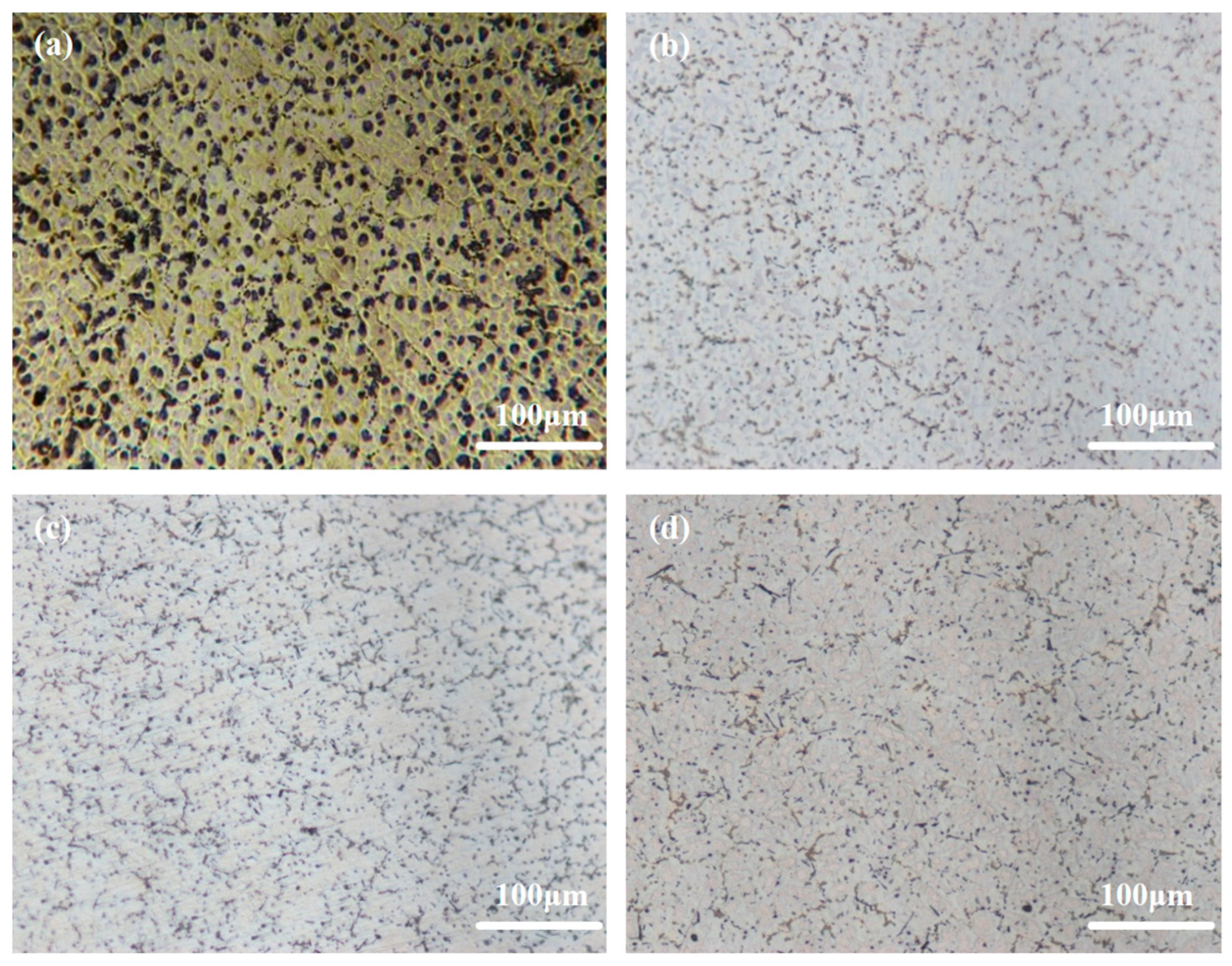
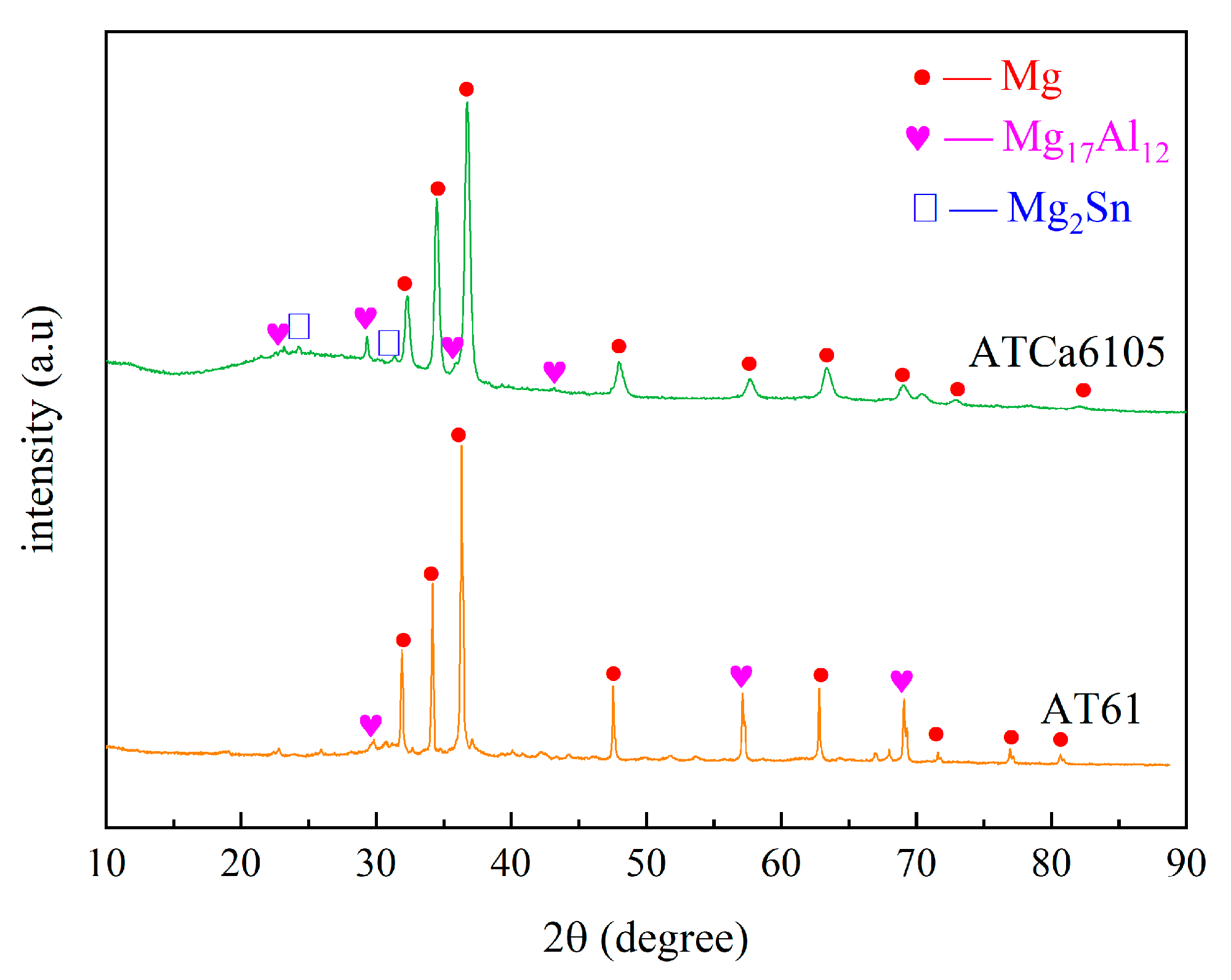

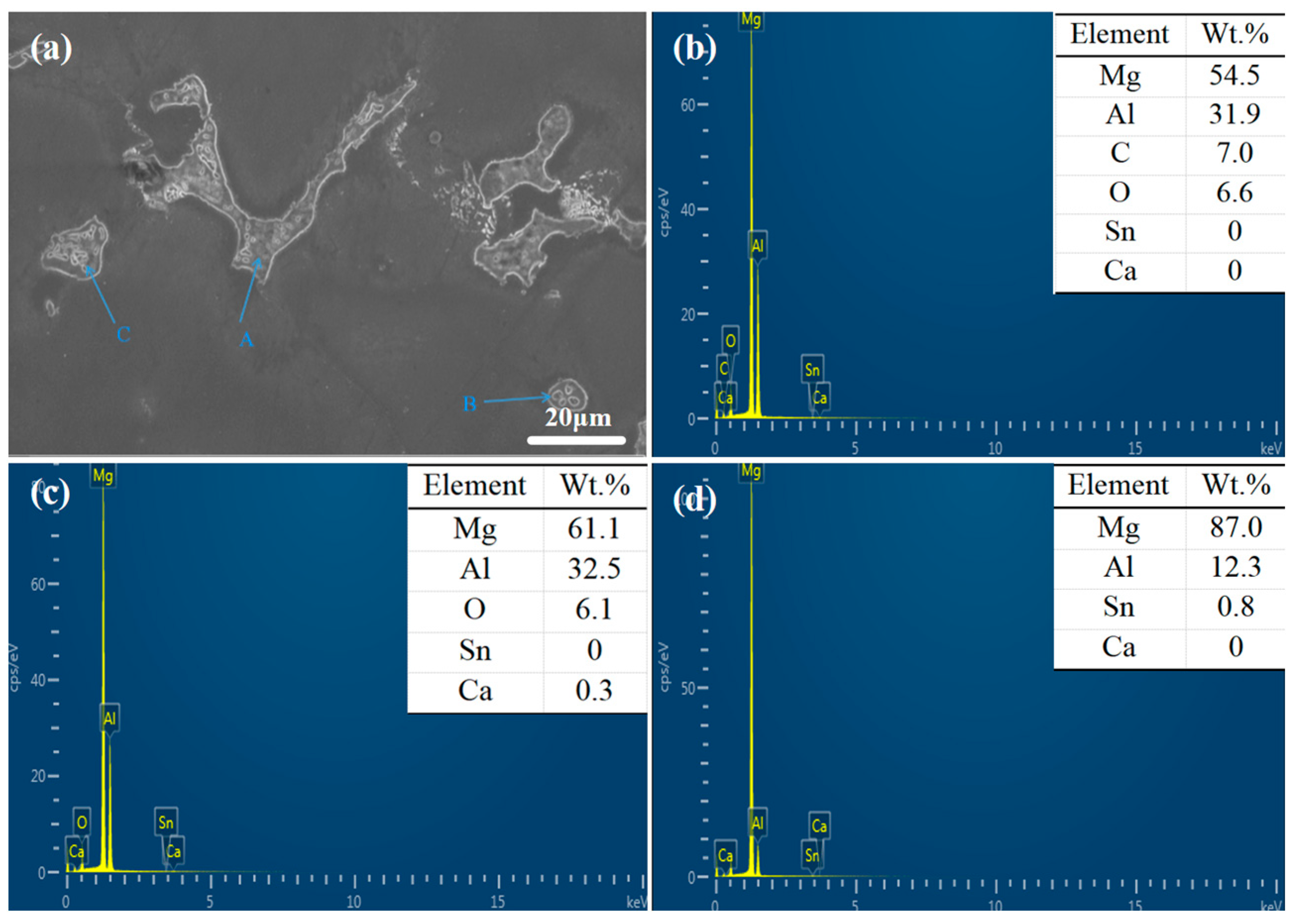




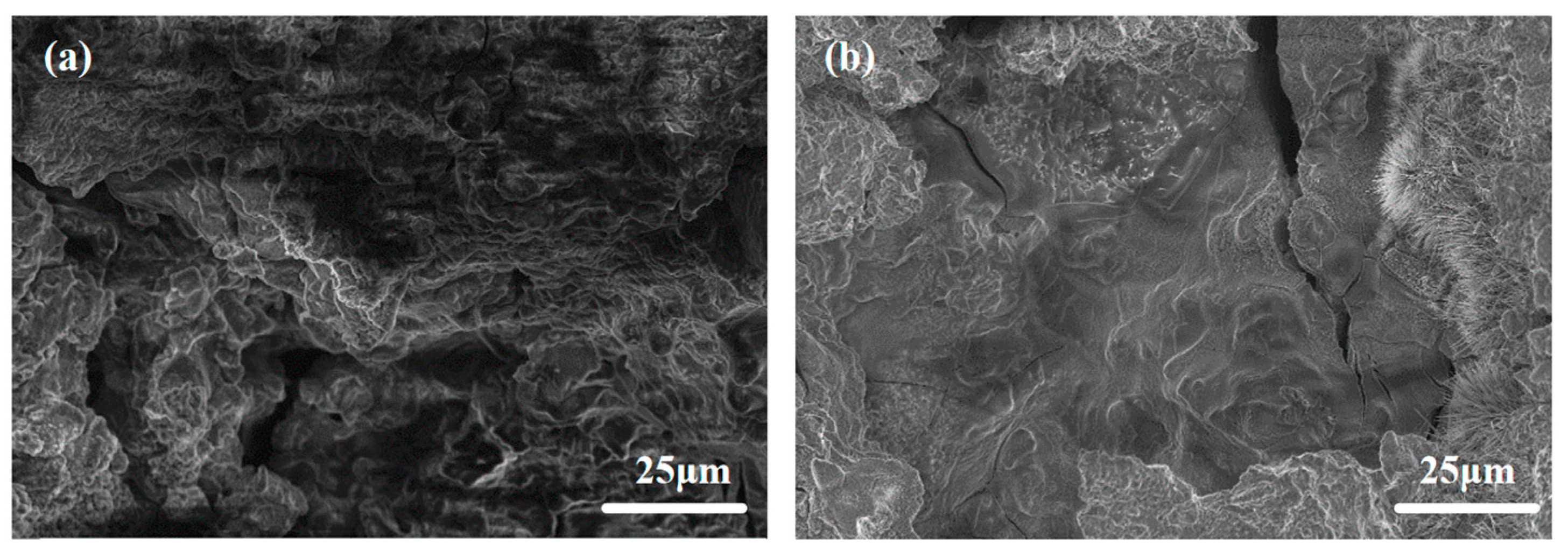

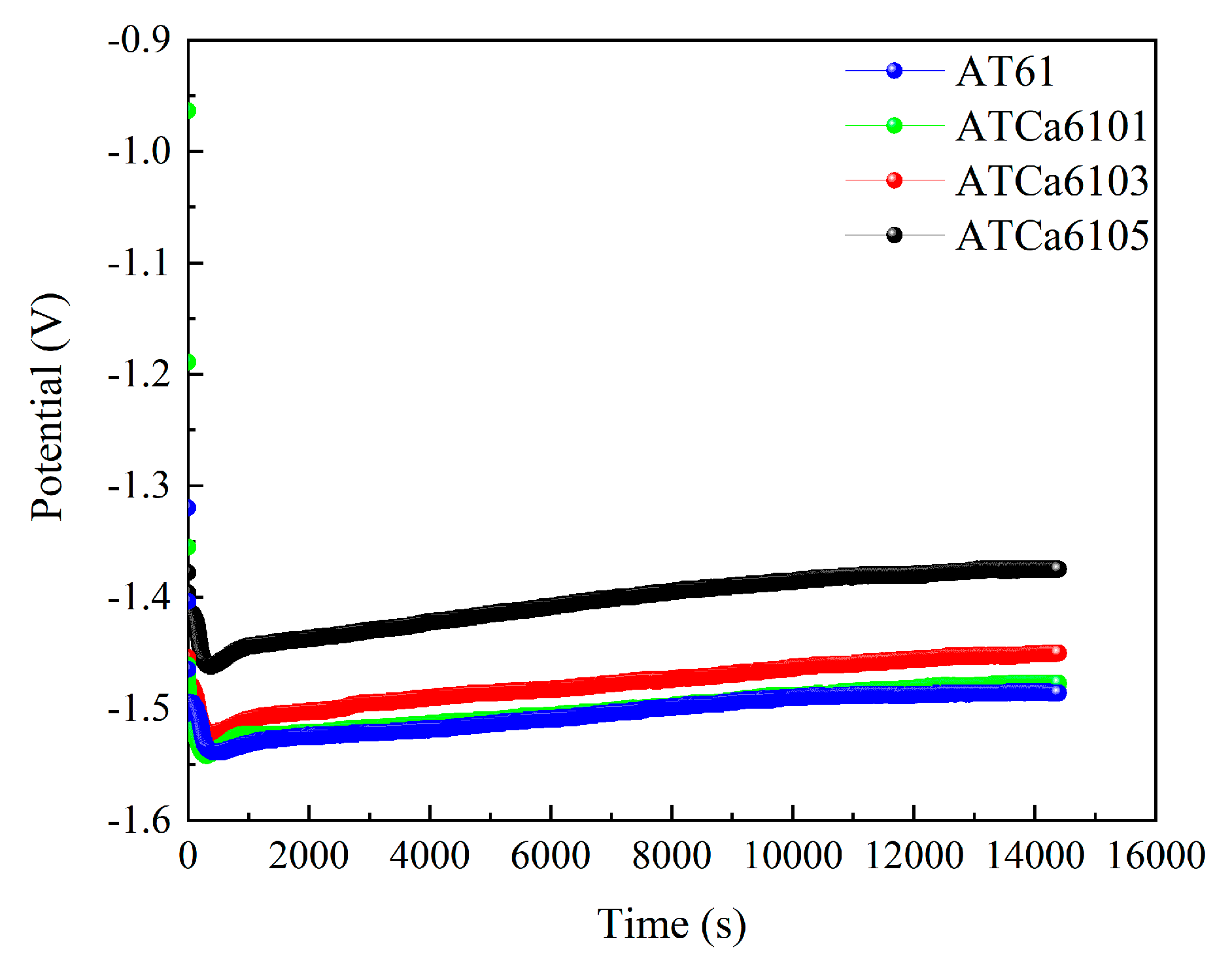

| Anode Designation (Code) | Chemical Composition (wt.%) | ||||
|---|---|---|---|---|---|
| Al | Sn | Ca | Mn | Mg | |
| Mg-6Al-1Sn (AT61) | 5.87 | 1.12 | - | 0.27 | bal |
| Mg-6Al-1Sn-0.1Ca (ATCa6101) | 5.78 | 0.98 | 0.12 | 0.29 | bal |
| Mg-6Al-1Sn-0.3Ca (ATCa6103) | 6.12 | 0.93 | 0.28 | 0.28 | bal |
| Mg-6Al-1Sn-0.5Ca (ATCa6105) | 5.89 | 0.95 | 0.53 | 0.26 | bal |
| Alloy | (V vs. SCE)/V | /(A/cm2) |
|---|---|---|
| AT61 | −1.557 | 1.126 × 10−4 |
| ATCa6101 | −1.523 | 5.598 × 10−5 |
| ATCa6103 | −1.525 | 2.969 × 10−5 |
| ATCa6105 | −1.492 | 9.43 × 10−6 |
| Alloy | AT61 | ATCa6101 | ATCa6103 | ATCa6105 |
|---|---|---|---|---|
| RS/Ω·cm2 | 0.01 | 2.837 | 3.093 | 4.815 |
| CPEdl/Ω−1·cm−2·sn | 1.054 × 10−4 | 1.013 × 10−5 | 1.413 × 10−5 | 1.473 × 10−6 |
| Rt/Ω·cm2 | 52.1 | 404.3 | 473.7 | 540.61 |
| CPE1/Ω−1·cm−2·sn | 3.334 × 10−4 | 1.093 × 10−5 | 2.297 × 10−6 | 1.679 × 10−6 |
| R1/Ω·cm2 | 8.133 | 6.826 | 10.42 | 6.681 |
| C/μF | 1.004 × 10−5 | 6.111 × 10−5 | 5.147 × 10−5 | 4.31 × 10−5 |
| R2/Ω·cm2 | 18.1 | 4.361 | 6.594 | 2.067 |
| Component | Initial Mass/mg | Final Mass/mg | Actual Measurement/mm2 |
|---|---|---|---|
| AT61 | 1335.3 | 1339.8 | 10.75 × 10.70 |
| ATCa6101 | 1331.4 | 1329.8 | 9.65 × 9.67 |
| ATCa6103 | 1441.5 | 1437.9 | 9.48 × 9.60 |
| ATCa6105 | 1394.9 | 1388.4 | 9.60 × 9.78 |
Disclaimer/Publisher’s Note: The statements, opinions and data contained in all publications are solely those of the individual author(s) and contributor(s) and not of MDPI and/or the editor(s). MDPI and/or the editor(s) disclaim responsibility for any injury to people or property resulting from any ideas, methods, instructions or products referred to in the content. |
© 2025 by the authors. Licensee MDPI, Basel, Switzerland. This article is an open access article distributed under the terms and conditions of the Creative Commons Attribution (CC BY) license (https://creativecommons.org/licenses/by/4.0/).
Share and Cite
Wan, X.; Kang, C.; Tian, Q.; Zhou, J.; Qian, S.; Ma, C. Effect of Ca Content on Electrochemical Discharge and Corrosion Performance of Mg-6Al-1Sn Alloy Anodes for Mg-Air Batteries. Materials 2025, 18, 1562. https://doi.org/10.3390/ma18071562
Wan X, Kang C, Tian Q, Zhou J, Qian S, Ma C. Effect of Ca Content on Electrochemical Discharge and Corrosion Performance of Mg-6Al-1Sn Alloy Anodes for Mg-Air Batteries. Materials. 2025; 18(7):1562. https://doi.org/10.3390/ma18071562
Chicago/Turabian StyleWan, Xiaofeng, Chenyuan Kang, Qiyuan Tian, Jingling Zhou, Shuangqing Qian, and Chunhui Ma. 2025. "Effect of Ca Content on Electrochemical Discharge and Corrosion Performance of Mg-6Al-1Sn Alloy Anodes for Mg-Air Batteries" Materials 18, no. 7: 1562. https://doi.org/10.3390/ma18071562
APA StyleWan, X., Kang, C., Tian, Q., Zhou, J., Qian, S., & Ma, C. (2025). Effect of Ca Content on Electrochemical Discharge and Corrosion Performance of Mg-6Al-1Sn Alloy Anodes for Mg-Air Batteries. Materials, 18(7), 1562. https://doi.org/10.3390/ma18071562





